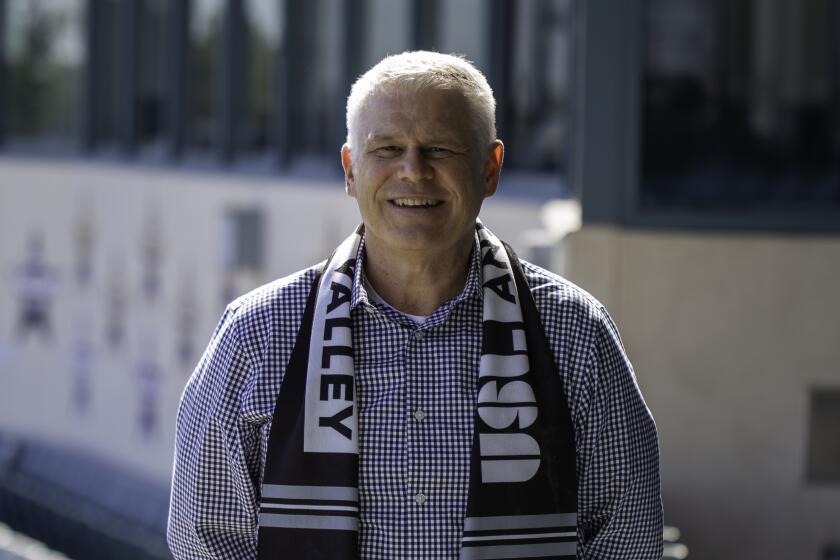Tennis’ Growing Pains
Whipping her large, lightweight racket to hit punishing forehands from deep in the court, Ashley Maddocks never considered the punishment her right shoulder was also taking.
That was before rotator-cuff surgery halted her climb up the Southern California junior tennis rankings and forced her to reconsider plans for a college and professional career. She acknowledges now that she should have paid more attention to her coaches--and to her body.
“I’ve always just gone out and started banging balls way too hard,” said Maddocks, a 16-year-old from Laguna Beach. “People would always tell me to slow down, but I didn’t listen. I never stretched before or after I played. I guess it all caught up to me.”
In a quest to become the best in their age group, a top college prospect or ultimately the next Venus Williams or Pete Sampras, teenage tennis players such as Maddocks are increasingly over-training, over-playing and over-working their underdeveloped bodies, experts say.
Players are focusing too heavily on tennis at a young age, leaving little or no time for them to enjoy a variety of sports that would help develop muscles in other areas of their bodies. Improper techniques put further stress on growing joints. Adding to the problem are unrelenting year-round play and back-to-back tournaments: The Ojai, the nation’s largest and oldest amateur competition, starts Thursday, only a week after the grueling, eight-day Easter Bowl national tournament ended in Palm Springs.
As a result, young players’ backs, shoulders, elbows, wrists, ankles and feet are breaking down at an alarming rate, according to coaches nationwide, experts in sports medicine and several new studies.
“This quest for excellence, money and fame starts too early for these kids,” said Greg Patton, a West Coast coordinator for the U.S. Tennis Assn., which has more than 150,000 members between the ages of 10 and 18. “They strangulate themselves on the ropes, trying to get to the top.”
A four-year study of boys and girls playing at USTA national 16-and-under tournaments supports that claim.
The study, conducted by Dr. Marc Safran of Kaiser Permanente in Anaheim and Dr. Mark Hutchinson of the University of Illinois-Chicago, found that nearly one in five players suffered new or recurring injuries during the weeklong tournaments. Recent injuries had sidelined 77% of the girls and 55% of the boys for a week or more.
Seena Hamilton, founder and director of the Easter Bowl--a prestigious tournament that attracts hundreds of players nationwide--has been tracking injuries since 1996, when 25 injured players withdrew from her event before it began and about 100 more were injured during what was then a nine-day competition.
A survey of 492 young players that year found that 62% had suffered one or more injuries that sidelined them for at least three days in their careers. And the problem is worsening.
At the Easter Bowl, which ended April 19, there were 47 players who withdrew because of injuries before the competition began. After eight days, 212 had been treated by the trainer for injuries or injury prevention.
“That’s alarming,” said Tom Gullikson, former U.S. Davis Cup captain and current director of coaching for USA Tennis player development. “That’s a high number of injuries, especially for the first big tournament of the year.”
Alarming, but not entirely surprising given the pressure the players are under.
“These kids are playing for invitations to other tournaments, grants and recognition from college coaches,” Hamilton said. “We had a lot of these kids coming in here hurt.”
Evidence of nagging injuries isn’t hard to find.
“When you go to tournaments, you see everyone with ice on their backs, their wrists,” said Megan Biorkman, an Irvine University High junior, as she iced her wrist and back injuries at a recent junior event. “People are breaking down all over the place.”
Whether today’s young players are injured more than those who played with smaller wood rackets in the 1960s and 1970s is difficult to say because there is insufficient data.
What is known is this: Rackets have become larger and lighter in the last 20 years, and that has changed the way the game is played. Young players compensate for poor form by overpowering the ball with the stronger rackets.
“Top juniors don’t have to turn sideways to the net as much,” said Dr. Paul Roetert, a bio-mechanic specialist and a former director of sports science for the USTA. “Instead of having that nice flowing motion going in the direction of the target, players are using open stances and whipping the racket to create a lot of torque.”
Over an 11-year period beginning in 1988, Roetert examined the type of injuries juniors were suffering and found that about half occurred in the shoulder and lower back, which he attributes to excessive upper-body rotation caused by open stances and powerful rackets.
Many players play through pain.
Brittany Reitz, a junior at Corona del Mar High, strained her back while preparing for the Easter Bowl yet didn’t consider withdrawing because of the tournament’s magnitude.
The injury limited her movement and she lost in the second round of the girls’ 18s main draw. Bags of ice, anti-inflammatory pills and nightly phone calls to her physical therapist kept her in the consolation round for three more days. Finally, Reitz withdrew from her sixth match in four days after resorting to an underhanded serve.
“I taught myself a lesson,” Reitz said. “Next time, I’ll pull out and save myself the chance of doing some permanent damage.”
Judith DeVera of Carson High entered the girls’ 16 Easter Bowl draw with a nagging arch injury. She reached the doubles semifinals by plunging her foot in alternating ice and hot water baths and taking plenty of Advil before matches.
“If you play a sport, you want to fight till the end,” she said. “If you can stand the pain, you have to keep going.”
Pressure to keep up with the competition is a driving force. A 1988 USTA survey found that nationally-ranked juniors play tennis for more than four hours a day, 360 days a year.
“Then they add the stress put on by parents and coaches,” said Patton, the USTA coordinator who was formerly a successful men’s college coach at UC Irvine and Boise State. “It’s like gorging yourself with good food. Eventually, you’re going to get sick.”
The potential for a college scholarship or a place on the pro tour encourages young players to keep pushing.
Aaron Yovan, a junior at Irvine University High, was hoping to impress college coaches when he decided to juggle high school playoffs with a national tournament last June.
The eight grueling matches he played during that six-day period caught up to him while playing in the Southern California Junior Sectionals that followed. A strained lower back forced him to withdraw, and he missed two USTA national tournaments later that summer.
“High school is more of a team and pride thing,” said Ron Yovan, Aaron’s father. “You want to be there for your school. And Aaron also wanted to play the national tournament for its visibility. But he got run down and he eventually broke down. We’ve learned our lesson. Now if he goes through a tough tournament, we’ll take four or five days off.”
But many junior tennis players won’t, even though experts agree that rest is critical, especially for pre-pubescent teens.
The risk of injury is heightened by year-round competition and a ranking system that rewards active players who win a high percentage of their matches against highly-ranked opponents.
Rest doesn’t only mean avoiding matches. Some coaches believe marathon practice sessions are more damaging than match play.
“The drilling wears you down,” said Mike Nelson, tennis pro at Ridgeline Tennis Club in Orange. “In a two-hour match, you really might only play about 30 minutes of tennis. . . . In an hour’s worth of drilling, you’re hitting for 40 minutes.”
Because of his intimate knowledge of stretching, cross-training, yoga and light weights, Nelson has crafted a carefully balanced program for his daughter, Lindsey, who has climbed to the top of the girls’ 16 rankings in Southern California and to No. 2 nationally, while staying relatively injury free.
“I usually give Lindsey 20 minutes of drilling, then we go play a set,” Nelson said.
Still, there are no guarantees against injury. Lindsey Nelson suffered a pulled stomach muscle in the fourth round of the Easter Bowl, and later lost in the finals. But her conditioning will likely help her make a more speedy recovery.
The troubling number of injuries at the junior and adult levels helped spur Roetert, the former USTA sports science director, to write a book, “World Class Tennis Technique.” In it, he argues that players could stave off injury if they follow the sport’s greatest names and become more efficient with their time.
“Jimmy Connors practiced an hour a day,” Roetert said. “It should be about quality of practice time, rather than quantity.”
With only an hour a day devoted to tennis, Connors had time to pursue other sports, as did many of his competitors during their junior careers.
“John McEnroe played soccer, Bjorn Borg and Ivan Lendl played hockey and Stan Smith was an excellent basketball player,” Roetert said. “There’s no need for any of these kids to specialize before they’re 14.”
Arpi Kojian, a senior at Villa Park High, once was one of those kids.
Three years ago, Kojian was a top 30 national player and on track to being a highly recruited junior. She never seriously considered preventive measures such as cross-training.
“And I think that killed me,” Kojian said.
For two years, she tried to ignore the pain in her right shoulder. The nerve damage would later sideline her, dropping her ranking, lowering her expectations and changing her perspective.
“If I felt like it, I could still go play college tennis and pursue a pro career,” Kojian said. “But I do have other options. The injury was a real eye-opener.”
What should also come first for young tennis players is a well-organized conditioning and nutrition program, experts said.
The USTA offers an information network of clinics and seminars that are free for all members, and emphasize injury prevention.
“We try to get as much information as we can out to the parents, players and the coaches,” Gullikson said.
But it seems that not enough players are being reached.
Maddocks was raised in an athletic family. Her mother, Tara, played volleyball in high school, and her father, Tom, was an All-American swimmer at Alabama. Maddocks played soccer and tennis as a youngster, but quickly took to tennis when she was 9.
Her parents thought her attraction to the sport was healthy, and never thought she might be in danger.
When her daughter was hurt, she was still eager to get back on the court. Looking back on it, Tara Maddocks wished she had stopped her.
Maddocks is only beginning to hit tennis balls again after her January surgery. Although she has fallen out of the rankings and out of the minds of most college coaches, she still hopes to play tennis in college and possibly professionally. But she is starting to contemplate other options.
“You think about tennis being your life before you get hurt,” Maddocks said. “I do know I have other things to fall back on. I get good grades. There’s not just one thing I’m talented at.”
(BEGIN TEXT OF INFOBOX / INFOGRAPHIC)
Tenn Tennis Injuries
Teenagers involved in competitive tennis tournaments are increasingly suffering new and repetitive injuries caused by overuse, according to a recently released four-year study funded by the United States Tennis Assn.
101ST OJAI VALLEY TENNIS TOURNAMENT
* What: Pacific 10 Conference individual tournament featuring NCAA men’s singles champion Alex Kim of Stanford; thirty-four divisions, including college, open and junior events.
* When: Today through Sunday.
* Where: Libbey Park in downtown Ojai is tournament headquarters.
More to Read
Get our high school sports newsletter
Prep Rally is devoted to the SoCal high school sports experience, bringing you scores, stories and a behind-the-scenes look at what makes prep sports so popular.
You may occasionally receive promotional content from the Los Angeles Times.






